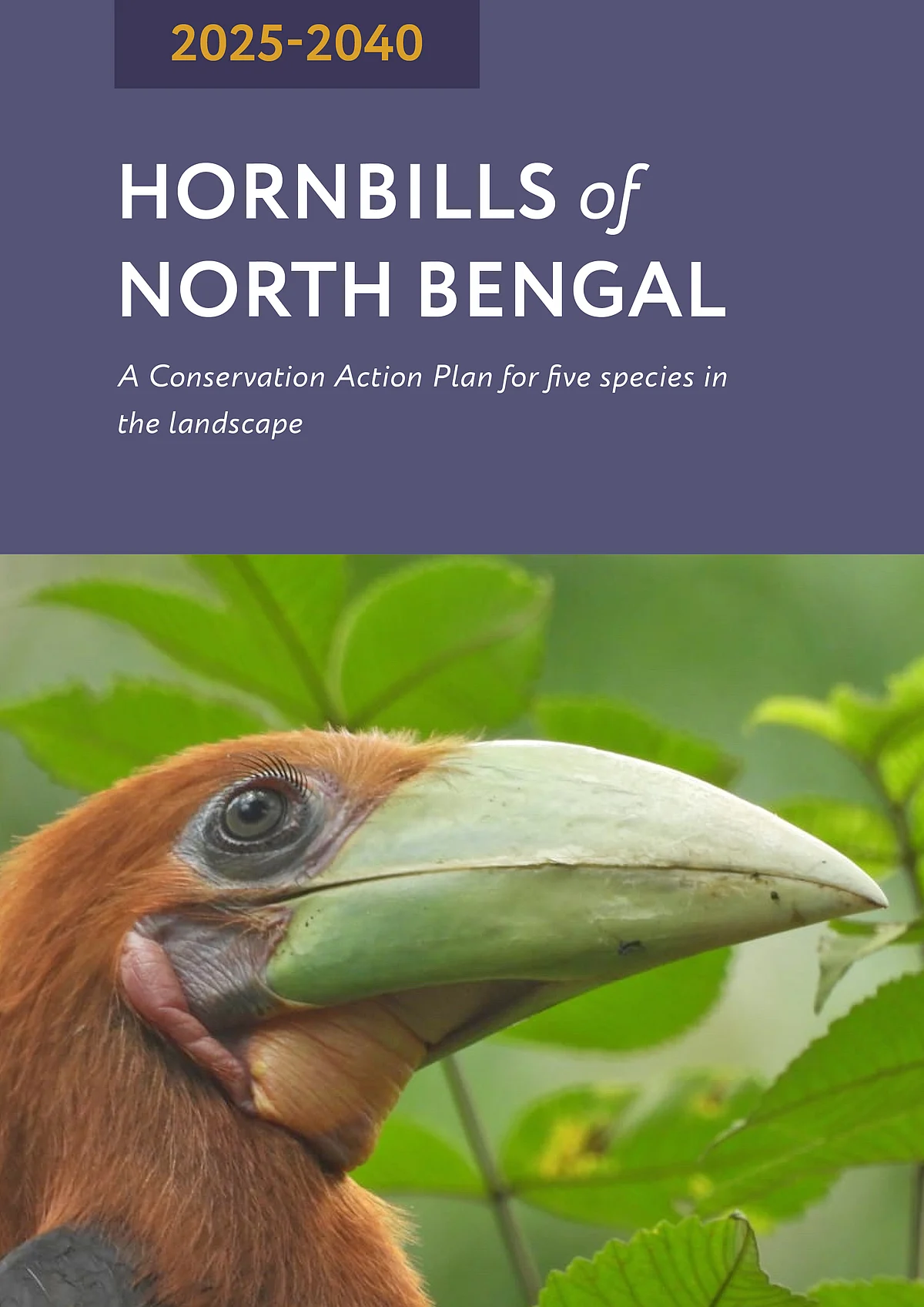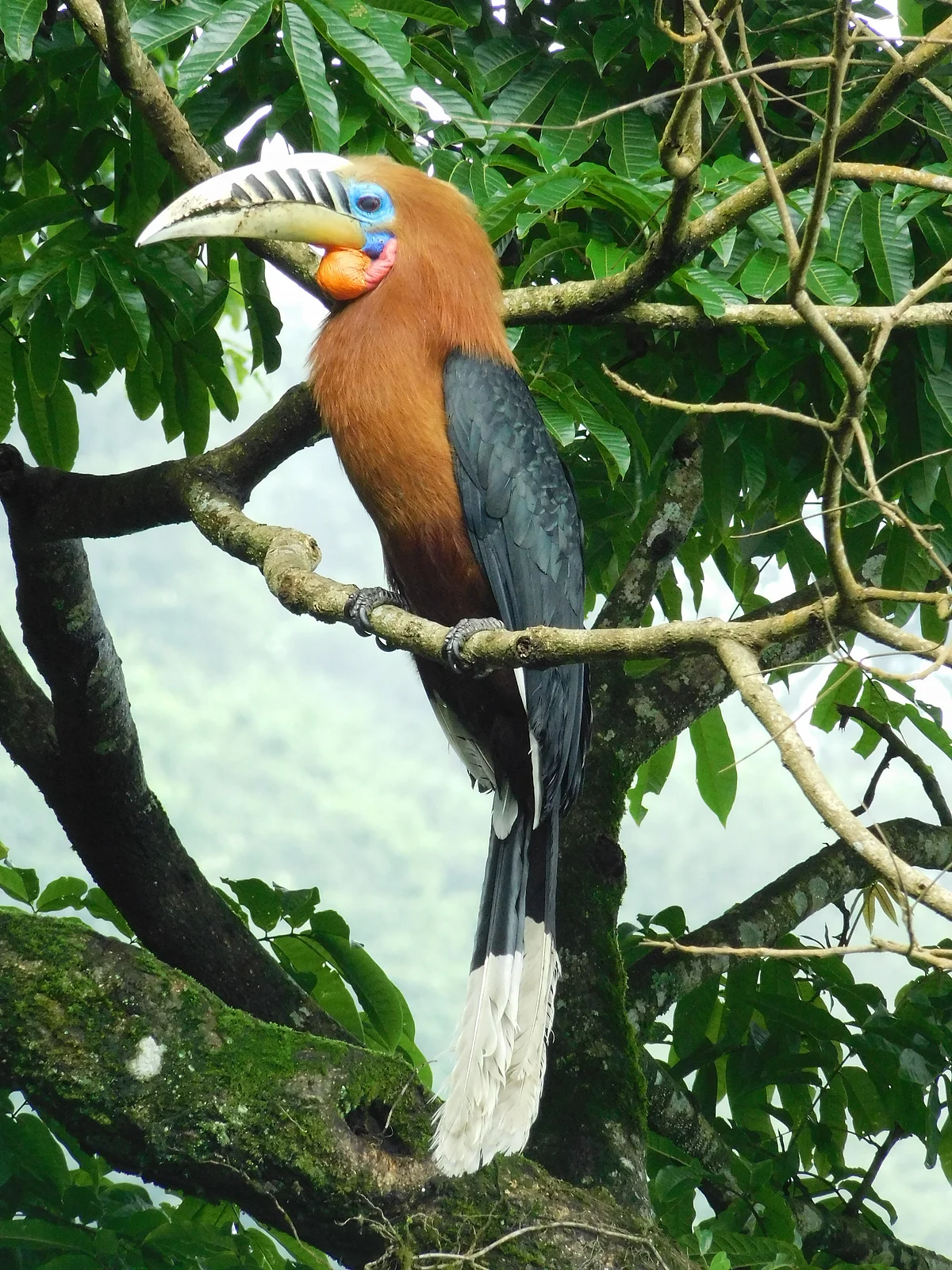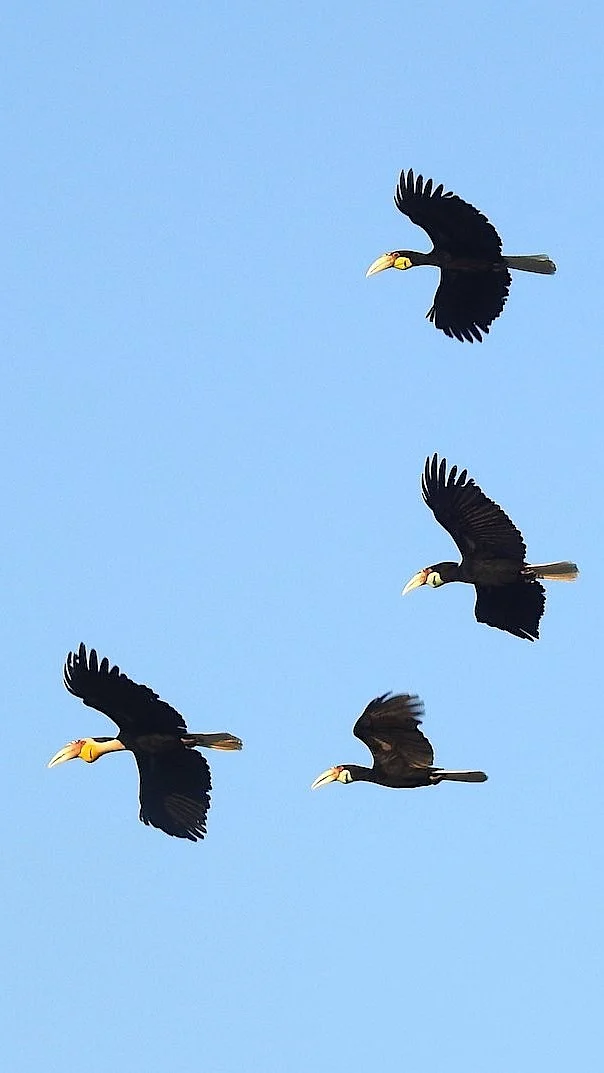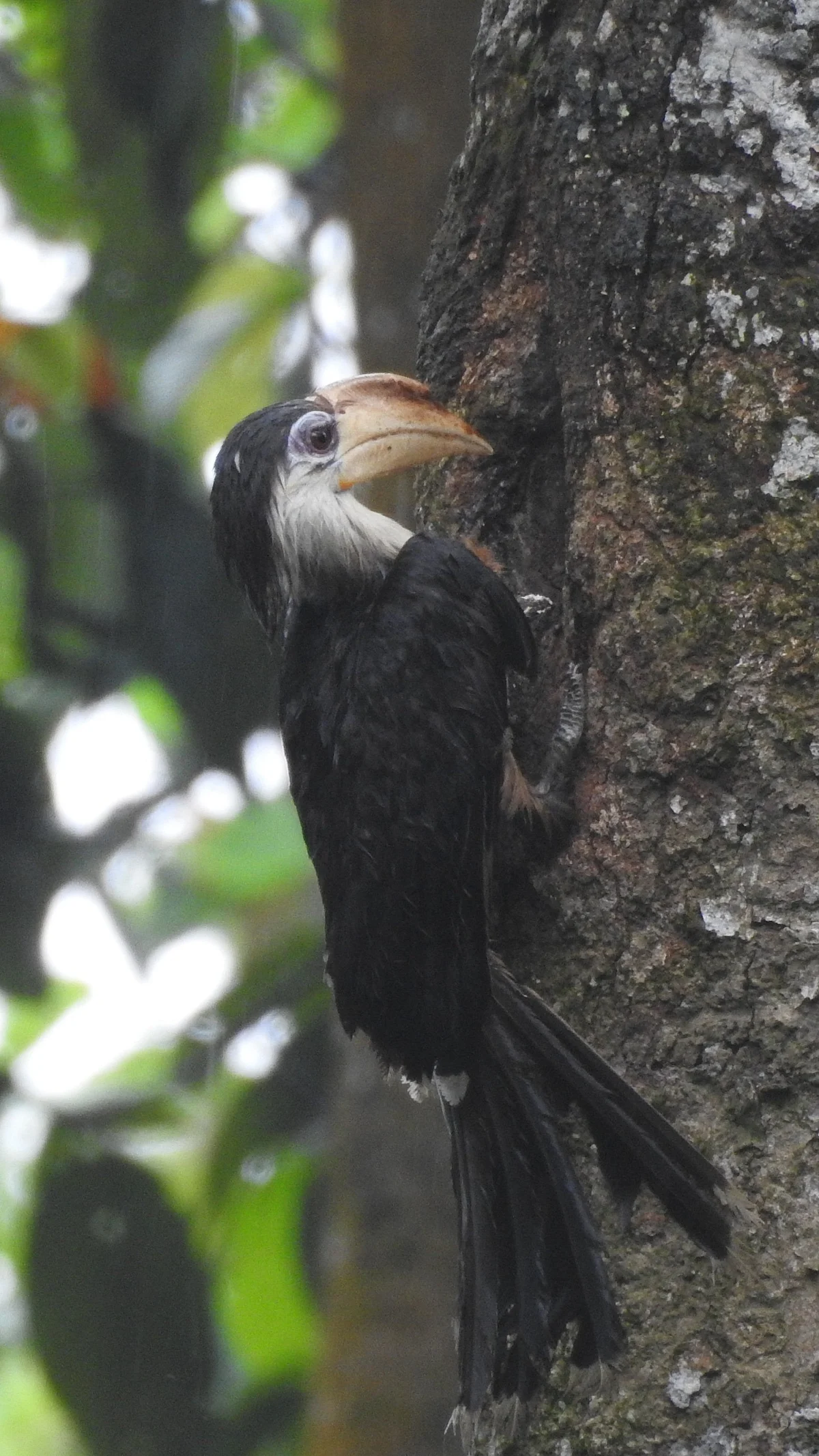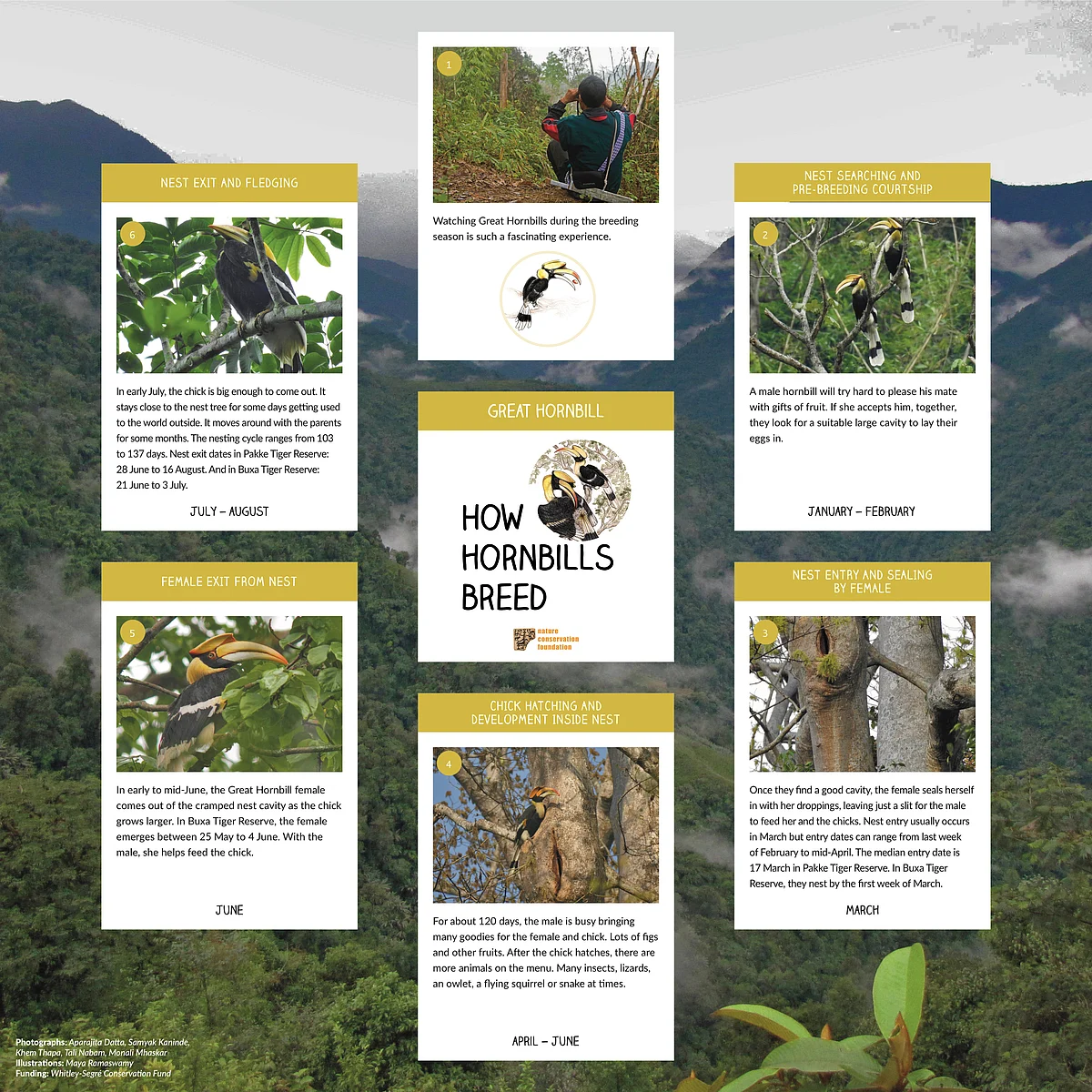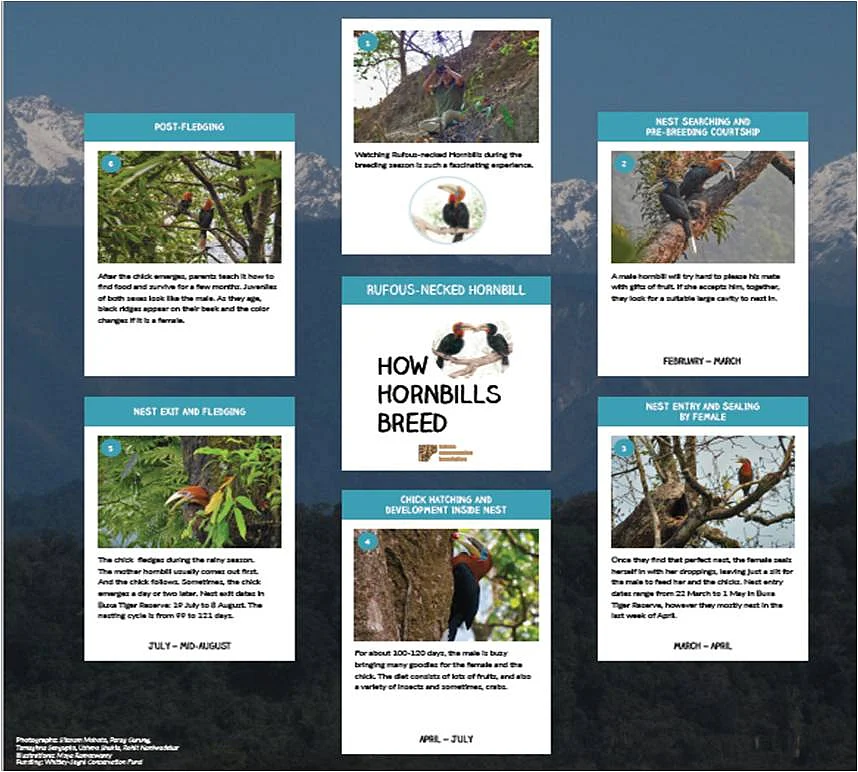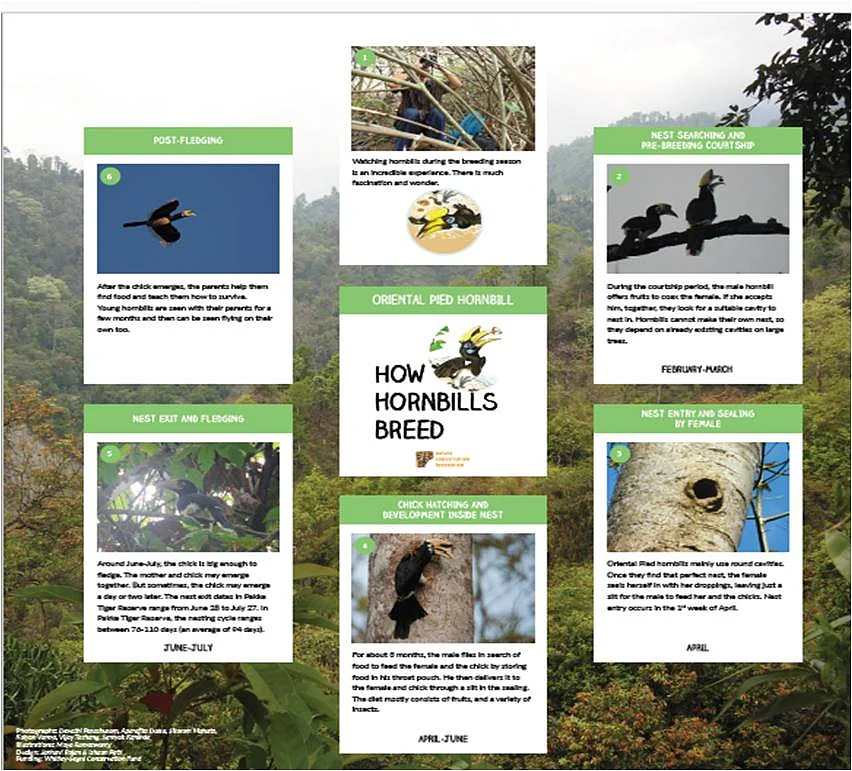How Hornbills Breed: Rufous-necked HornbillIncreasing the scope of hornbill conservation and protection of their habitats by partnering with government and local community institutions in Arunachal Pradesh, Assam and West Bengal.
Securing conservation in new sites
Hornbills are large birds moving over large landscapes and they face multiple threats due to human activities (habitat loss due to illegal logging, agricultural clearing and cash crop expansion) and hunting. Their long-term survival needs to be ensured outside the small islands of Protected Areas.
The Hornbill Nest Adoption Program is a relatively successful model for community-based conservation, which was adopted in 2011 to protect breeding populations of hornbills that occur outside Pakke Tiger Reserve, Arunachal Pradesh. Since 2017, we are trying to take this model to other sites in north-east India. However, we are modifying the model to engage with local partners in new ways, based on local context, to establish a long-term hornbill monitoring and protection network.
Dihing-Patkai landscape in Eastern Assam
Brown Hornbills are a little-known and rare species with their westernmost distributional limit in north-east India. They are usually found in flocks and, unlike other hornbill species found in India, they exhibit a co-operative breeding system. During the breeding season, males are assisted by other male helpers to feed the female and chicks at the nest and guard them from potential threats.
Jeypore Reserve Forest and Dihing-Patkai Wildlife Sanctuary along with 25 forest fragments, form a landscape which is the last remaining contiguous lowland dipterocarp-dominated forests in eastern Assam. The forests are home to many elusive species like the Golden cat, Western Hoolock Gibbon, Stump-tailed macaque and Clouded leopard to name a few. Based on prior knowledge of the distribution of Brown hornbills in the landscape, we started working on the species in 2017.
Successful conservation of Brown Hornbill necessitates a thorough understanding of their environmental requirements and constraints. Our research attempts to assess the status of Brown Hornbill populations and to study their behavior and breeding biology. We have found 9 Brown Hornbill nests, 2 Oriental Pied Hornbill and 1 Great Hornbill nest in the landscape till 2019. We have recorded 10 successful fledglings of Brown hornbill from 2017-2019.
We have set up a collaboration with Digboi College-Assam by signing an MoU to facilitate training and capacity-building of students and for undertaking conservation work with the local communities in the area. We are also actively engaging with the Forest Department regarding our findings to formulate solutions to the local conservation issues in the landscape.
Upper Siang district, Central Arunachal
Upper Siang district, situated in the Central-northern part of Arunachal Pradesh, is comprised of forested hilly ranges with moderate to steep slopes and narrow valleys, separated by the Siang River and its tributaries. The elevation varies from 1100 to > 4000m asl. With its dense vegetation and hilly terrain, this area is home to many endangered fauna such as takin and goral, as well as to the Adi tribal community, who are prolific hunters. On earlier surveys, we had confirmed the presence of the globally endangered Rufous-Necked Hornbills (RNH) here, while identifying threats such as expanding human populations, cultural hunting, infrastructure development (roads and hydropower) and climate change.
We are focusing on three villages in the area - Migging, Mosing and Bomdo. Understanding spatiotemporal variation in hornbill densities provides crucial information for formulating effective conservation. But in addition to field surveys, we are also conducting interviews to get a better sense of the local community’s perceptions towards RNH. This will help to strengthen conservation through the participation of the local community, while respecting the tribal rights to their territories and cultural practices.
Hornbill research and conservation in North Bengal
Five species of hornbills are found in North Bengal - the Great Hornbill (Buceros bicornis), Indian Grey Hornbill (Ocyceros birostris), Oriental Pied Hornbill (Anthracoceros albirostris), Rufous-necked Hornbill (Aceros nipalensis) and Wreathed Hornbill (Rhyticeros undulatus). The Great, Wreathed and Rufous-necked Hornbills are globally threatened and are listed as Vulnerable by the IUCN Red List (Birdlife International 2020). The Oriental Pied and Indian Grey Hornbills are listed as ‘Least Concern’ and the latter species is mostly found in agricultural, semi-rural landscapes and near urban settlements. North Bengal is also the westernmost limit of the global distributional range for the Wreathed and Rufous-necked Hornbills.
We started the hornbill research and conservation work in North Bengal in November 2017 in collaboration with Nature-Mates Nature Club, a Kolkata-based NGO. The broad objectives of the hornbill research and conservation project were to:
1) Collect baseline information on hornbill ecology (population status, breeding, roosting, diet) of all four sympatric hornbill species found in the North Bengal landscape.
2) Quantify and understand the vegetation structure and composition of hornbill habitats.
3) Initiate hornbill conservation in collaboration with the West Bengal Forest Department and other important stakeholder groups.
Since 2017, we have worked extensively to understand hornbills and their habitat in Buxa Tiger Reserve and since 2021 in Latpanchar, fringe village of Mahananda Wildlife Sanctuary. Apart from these, short surveys for hornbills have also been conducted in Mahananda Wildlife Sanctuary, Neora Valley National Park and Jaldapara National Park.
At Buxa Tiger Reserve, we surveyed the park over two non-breeding seasons to estimate hornbill densities and abundance. This was the first detailed baseline of the hornbill population from North Bengal. The estimated density of the three large-bodied species – Great Hornbill (GH), Wreathed Hornbill (WH) and Rufous-necked Hornbill (RNH), was < 1bird per km2, while that of the Oriental Pied Hornbill (OPH) was around 11 birds per km2 (Pradhan et al. 2024). We have also located and monitored 47 hornbill nests of four species in Buxa Tiger Reserve since 2018 and six hornbill nests of two species in Latpanchar and the Mahananda Wildlife Sanctuary since 2022. The nesting period varies across species but largely takes place between March to August at both sites. The mean nesting duration in Buxa for GH is 117 days (SD ± 2.65), OPH is 88 days (SD ± 5.20), RNH is 118 days (SD ± 2.65) and WH is 133 days (SD ± 9). The average nesting success of hornbill nests in Buxa TR is 81% (range of 50–100 %) from 2018 to 2024 and at Latpanchar the average nesting success is 88.89% from 2022 to 2024 (range of 66 – 100%). We have also observed inter-species competition for nests and nest takeovers. Until now, we have recorded over 35 hornbill food plants from North Bengal and 25 tree species used for nesting by the four species of hornbills.
Additionally, we monitor seven roost sites in Buxa Tiger Reserve: four of these sites are used by the Great Hornbill (GH) and are located in hill forest patches close to small water bodies. Three sites are used by Wreathed Hornbill (WH) in riverine habitats (Mandal et al., 2024). The count of GH individuals at roost sites range from 1 – 20 individuals daily, whereas the WH numbers range from 1-224 individuals daily (Mandal et al., 2024). The number of birds visiting the roost sites decreases in the breeding season.
The vegetation surveys in Buxa Tiger Reserve estimate the average tree density as 91.9 trees/ha (SE ± 7.5) with the overall tree density (GBH ≥ 25 cm) ranging from 7.8 to 425.6 trees/ha across the 81 trails that were sampled (Pradhan et al., 2024). Since 2021, we have also been studying the tree phenology of selected species to understand the seasonal and annual patterns of leafing, flowering and fruiting of 63 tree species in Buxa TR and 23 tree species in Latpanchar.
We have also conducted hornbills surveys and vegetation sampling in Mahananda Wildlife Sanctuary, Neora Valley National Park and the adjoining forests of the Kalimpong Forest Division. We have also conducted household surveys and key informant interviews in 10 villages of Buxa Tiger Reserve and villages around the Mahananda Wildlife Sanctuary to understand resource needs at the household level, history of the landscape, people's perception towards hornbills and their relationships with the forest. In addition, we continue to conduct various workshops and trainings for key stakeholders in the region including the frontline staff of the Forest Department, nature guides and community representatives. We have also initiated a Nature Education Programme for local schools in Buxa Tiger Reserve since 2022 and engage with four schools of the East Division annually through nature camps, trails and other engaging activities.

